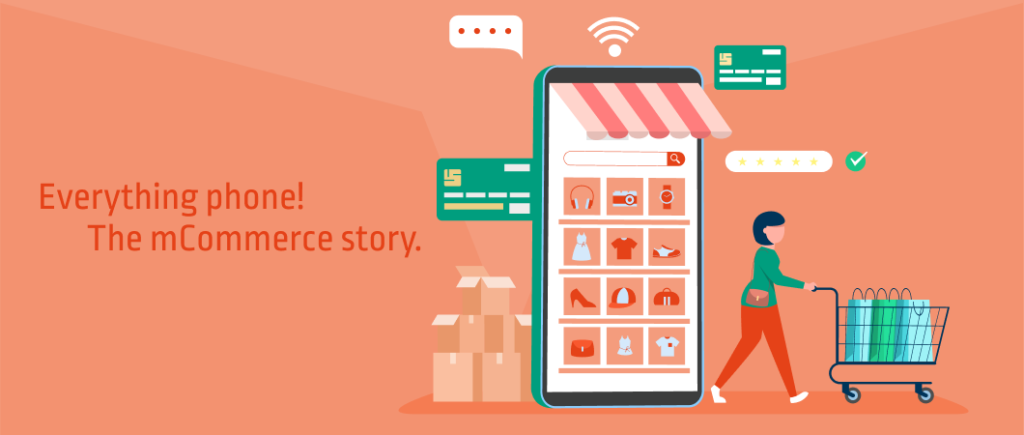Last updated on July 5th, 2024
From buying from physical stores to ordering anything and everything on our smartphones; consumer behavior has evolved. Today, around 6.378 billion people own a smartphone. From one landline per home to every individual owning a smartphone – the world has come a long way. Mobile phones have become an extended part of our lives. From waking up to alarms set on our phones to even watching movies on them mobility connects us all.
However, mobile phones have also doubled up as a favored medium for online shopping in the last few years. Mobile commerce is here and it’s making an impact.
What Is Mobile Commerce or mCommerce?
Mobile commerce, aka mCommerce, uses handheld wireless devices such as tablets and cellphones to complete a monetary transaction. The transactions include buying and selling products, bill payments, and online banking.
According to the research by Statista, mCommerce sales in the US rose by $431billion in 2022. Additionally, there has been a significant rise in the annual revenue from mCommerce, and experts anticipate that it will continue to grow.
Part of the rise can be attributed to the innovation mCommerce enables. While mCommerce is a part of eCommerce, mCommerce has also served as a trigger for various new services and industries. Some of these include mobile money transfers, eTicketing and boarding passes, and the purchase and delivery of digital content.
Importance of mCommerce
With a significant rise in smartphones and tablets, customers are looking for eCommerce sites that offer uber-functional and engaging mobile apps to browse and shop through. Here are some of the reasons why mCommerce is important for businesses today:
- Rising Use of Smartphones: A Statista report shows a significant rise in smartphone users from 448.2 million in 2020 to about 55.9 million by 2023. Businesses without mobile apps risk losing customers to competitors who do.
- Quicker Purchase: Mobile sites load 1.5 times faster than traditional websites, enabling quicker purchases. Users can buy their favorite products with just a click on their smartphones without needing a quiet place to sit down and open a laptop.
- Increased Customer Attraction: Mobile-friendly businesses see higher sales and improved customer engagement. Studies show that about 67% of online shoppers prefer buying from mobile-friendly eCommerce sites, and 61% would leave sites that are not mobile-friendly.
- Customer Retention: Around 52% of customers avoid engaging with online stores that are not mobile-friendly. Additionally, 48% feel that a non-mobile-friendly interface indicates a lack of business interest in their customers.
- Competitive Edge: mCommerce allows businesses to leverage innovative technologies like artificial intelligence, chatbots, and single-click options. AI-enabled chatbots and voice assistants enhance the shopping experience, driving customer acquisition, conversion, and loyalty.
- Enhanced Shopping Experience: mCommerce apps offer a seamless and enjoyable shopping experience, making it easier for customers to browse, select, and purchase products.
- Convenience and Accessibility: With mCommerce, customers can shop anytime, anywhere, providing unparalleled convenience and accessibility compared to traditional eCommerce platforms.
mCommerce Trends to Watch out for in 2022
Some of the prominent mCommerce trends to watch out for in 2022 include:
· Progressive Web Apps (PWAs) are on the rise
· One-click ordering or buying
· Social commerce or the use of social media to target customers and create brand awareness
· Voice commerce or voice shopping.
· Mobile chatbots
· Mobile payments.
Of these, mobile payments are now a strategic focus for all retailers. According to Statista, more than $274 billion in payments will be processed through mobiles by 2022.
Types of mCommerce
There are essentially three types of mCommerce, and all the mCommerce-related activities fall under one of these heads.
1. Mobile shopping
2. Mobile banking
3. Mobile payments
That’s not to say that adopting mCommerce is easy. Powerful, robust, engaging, and secure mobile commerce sites are hard to develop, test, and maintain. Customer experience is a challenging goal as habits change and trends shift. That apart, the mCommerce strategy must be integrated into the wider enterprise technology strategy to ensure consistency, redundancy, and quality.
For organizations looking for a mobile app development partner that can help them get up and running with mCommerce, consider Forgeahead. Forgeahead with its mobile technology stack featuring iOS, Android, React Native, Flutter, and PhoneGap offers modern design, iOS and Android app development, and Cross-platform mobile apps. Talk to us about getting mCommerce ready.



